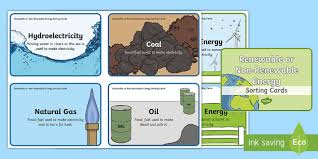Exploring Non-Renewable Energy Sources
Non-renewable energy sources are those that cannot be easily replenished within a short period of time. These energy sources have been traditionally used to power our homes, businesses, and industries, but their finite nature and environmental impact have led to a growing interest in renewable energy alternatives. Let’s explore some common examples of non-renewable energy sources:
Fossil Fuels:
Fossil fuels such as coal, oil, and natural gas are the most widely used non-renewable energy sources worldwide. These fuels are formed from the remains of ancient plants and animals that were buried and subjected to high pressure and heat over millions of years. While fossil fuels are abundant and provide a high energy density, their combustion releases greenhouse gases that contribute to climate change.
Nuclear Energy:
Nuclear energy is generated by splitting atoms in a process called nuclear fission. This process releases a tremendous amount of energy that is used to produce electricity in nuclear power plants. While nuclear energy does not produce greenhouse gas emissions during operation, it generates radioactive waste that poses long-term environmental and safety challenges.
Tar Sands:
Tar sands, also known as oil sands, are a mixture of sand, water, clay, and bitumen – a thick form of petroleum. Extracting oil from tar sands is an energy-intensive process that involves strip mining or underground drilling. The extraction and processing of tar sands have significant environmental impacts on land, water, and air quality.
Shale Gas:
Shale gas is natural gas trapped within shale rock formations deep underground. Hydraulic fracturing (fracking) is commonly used to extract shale gas by injecting high-pressure fluids into the rock to release the gas. While shale gas has become a major source of natural gas production, concerns about water pollution and seismic activity have raised environmental concerns.
In conclusion, while non-renewable energy sources continue to play a significant role in meeting global energy demands, their environmental consequences underscore the need for transitioning towards cleaner and more sustainable renewable energy alternatives.
Understanding Non-Renewable Energy: Common Questions and Examples
- What are the 10 examples of non-renewable resources?
- What are the 7 types of non renewable energy?
- What are 5 renewable non renewable?
- What products are non renewable energy?
What are the 10 examples of non-renewable resources?
Non-renewable resources are finite sources of energy that cannot be easily replenished within a short timeframe. Some common examples of non-renewable energy sources include fossil fuels such as coal, oil, and natural gas, as well as nuclear energy generated through nuclear fission. Other examples include tar sands, shale gas, and minerals like uranium and copper. While these resources have been essential for meeting global energy needs, their limited supply and environmental impacts highlight the importance of transitioning towards more sustainable renewable energy alternatives for a greener future.
What are the 7 types of non renewable energy?
There are seven main types of non-renewable energy sources commonly used to meet our energy needs. These include fossil fuels such as coal, oil, and natural gas, which have been the primary sources of energy for decades due to their high energy density. Nuclear energy, generated through nuclear fission, is another non-renewable source that produces electricity in nuclear power plants. Additionally, tar sands and shale gas are extracted for their oil and natural gas content, respectively. While these non-renewable energy sources have provided reliable energy supplies, their finite nature and environmental impacts have prompted a shift towards cleaner and more sustainable renewable energy alternatives.
What are 5 renewable non renewable?
When considering examples of non-renewable energy sources, it is important to distinguish between renewable and non-renewable options. Non-renewable energy sources include fossil fuels like coal, oil, and natural gas, as well as nuclear energy and unconventional sources such as tar sands and shale gas. These energy sources are finite and take millions of years to form, making them unsustainable in the long term. On the other hand, renewable energy sources like solar, wind, hydroelectric, geothermal, and biomass offer sustainable alternatives that can be replenished naturally over a relatively short period of time. By transitioning towards renewable energy sources, we can reduce our dependence on non-renewable options and mitigate environmental impacts associated with their extraction and use.
What products are non renewable energy?
Non-renewable energy sources are not products in the traditional sense; rather, they are natural resources that are extracted and processed to generate energy. Common examples of non-renewable energy sources include fossil fuels such as coal, oil, and natural gas, as well as nuclear energy derived from uranium. These resources are finite and take millions of years to form, making them unsustainable in the long term. It is important to explore alternative renewable energy sources to reduce our reliance on non-renewable energy and mitigate environmental impacts associated with their extraction and use.

